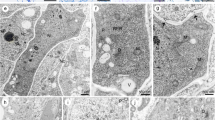Abstract
The ultrastructure of cystocarp development is described for the red alga Gelidium robustum (Gardn.) Hollenb and Abbott. The external cortical cells of the cystocarp remain uninucleate and unmodified, while the internal ones are binucleate, producing large mucilage sacs that discharge their contents into the cystocarpic cavity. Crystalline inclusions occur in both kinds of cells. Nutritive filaments, up to five cells long, are produced. Microtubules are associated with lipid droplets and occur in cells of the third-order filament, which probably function as food suppliers and food-conducting cells for the nutritive filaments. The younger, terminal cells of the nutritive filaments are electron-dense, having a large nucleus and lipid droplets and probably function as nutritive suppliers of the terminal gonimoblast cells. The older cells of the nutritive filaments are electron-light-possessing mucilage sacs, which function as mucilage suppliers of the cystocarpic cavity. Carpospore differentiation proceeds through three developmental stages. The youngest carpospores have an ovoid shape, possessing a large nucleus, proplastids with the peripheral thylakoid and some mucilage sacs, while they are surrounded by the carposporangial mucilage. Starch is polymerized in the perinuclear cytoplasmic area of the later stages of young carpospores. Intermediate-aged carpospores continue their starch polymerization and thylakoid development of plastids. Curved dictyosomes produce vesicles that contribute carpospore wall material. Mature carpospores have a nucleus, fully developed chloroplasts, numerous starch granules and adhesive vesicles, while they are surrounded by a two-layered wall and compressed mucilage, which constitutes a carposporangial wall.






Similar content being viewed by others
References
Abbott IA, Hollenberg GI (1976) Marine algae of California. Stanford University Press, Stanford
Akatsuka I (1986) Japanese Gelidiales (Rhodophyta) especially Gelidium. Oceanogr Mar Biol Annu Rev 24:171–263
Bold HW, Wynne MJ (1985) Introduction to the algae–structure and reproduction, 2nd edn. Prentice-Hall, Englewood Cliffs, N.J.
Delivopoulos S, Diannelidis BE (1991) Ultrastructure of carpospore differentiation in the red alga Alsidium corallinum C. Agardh. (Ceramiales, Rhodomelaceae). Ann Sci Nat Bot 13 2:23–31
Delivopoulos SG, Kugrens P (1984) Ultrastructure of carposporogenesis in the parasitic red alga Faucheocolax attenuata Setch (Rhodymeniales, Rhodymeniaceae). Am J Bot 71:1245–1259
Delivopoulos SG, Kugrens P (1985) Ultrastructure of the fusion cell in Gracilaria verrucosa (Huds) Papenfuss (Rhodophyta, Gigartinales). New Phytol 101:605–612
Delivopoulos SG, Tsekos I (1983) A light microscope study of carposporophyte development in Gracilaria verrucosa (Hudson) Papenfuss. Ann Bot 52:317–323
Dixon PS (1959) The structure and development of the reproductive organs and carposphorophyte in two British species of Gelidium. Ann Bot NS 23:397–407
Doyle WT (1962) The morphology and affinities of the liverwort Geothallus. Univ Calif Publ Bot 33:185–268
Duckett JG, Ligrone R (1992) A survey of diaspore liberation mechanisms and germination patterns in mosses. J Bryol 17:1–20
Duckett JG, Renzaglia KS (1993) The reproductive biology of the liverwort Blasia pusilla L. J Bryol 17:541–552
Fan KC (1961) Morphological studies of the Gelidiales. Univ Calif Publ Bot 32:315–368
Galatis B, Apostolakos P (1976) Associations between microbodies and a system of cytoplasmic tubules in oil-body cells of Marchantia. Plant 131:217–221
Glicksman M (1987) Utilization of seaweed hydrocolloids in the food industry. Hydrobiologia 151/152:31–47
Hommersand MH, Fredericq S (1988) An investigation of cystocarp development in Gelidium pteridifolium with a revised description of the Gelidiales (Rhodophyta). Phycologia 27:254–272
Kugrens P (1974) Light and electron microscopic studies of the development and liberation of Janczewskia gardneri Setch. spermatia (Rhodophyta). Phycologia 13:295–306
Kugrens P, Arif I (1981) Light and electron microscopic studies of the fusion cell in Asterocolax gardneri Setch (Rhodophyta, Ceramiales). J Phycol 17:215–223
Kugrens P, Delivopoulos SG (1986) Ultrastructure of the carposporophyte and carposporogenesis in the parasitic red alga Plocamiocolax pulvinata Setch. (Gigartinales, Plocamiaceae). J Phycol 22:8–21
Kugrens P, West JA (1973) The ultrastructure of carpospore differentiation in the parasitic red alga Levringiella gardneri (Setch) Kylin. Phycologia 12:163–173
Kwiatksowska M (1972) Changes in the diameter of microtubules connected with the autonomous rotary motion of the lipotubuloids (elaioplasts). Protoplasma 75:345–357
Kwiatksowska M (1973) Half unit membranes surrounding osmiophilic granules (lipid droplets) of the so-called lipotubuloid in Ornithogalum. Protoplasma 77:473–476
Kylin H (1928) Entwicklungsgeschichtliche Florideenstudien. Lunds Univ Arsskr, NF, Avd 2, 26 (4) 127 pp
Lembi CA, Waaland JR (eds) (1988) Algae and human affairs. Cambridge University Press, Cambridge
Ligrone R, Duckett JG (1994) Cytoplasmic polarity and endoplasmic microtubules associated with the nucleus and organelles are ubiquitous features of food-conducting cells in bryoid mosses (Bryophyta). New Phytol 127:601–614
Ligrone R, Lopes C (1989) Ultrastructure, development and cytochemistry of storage cells in the "tubers" of Phaeoceros laevis Prosk (Anthocerotophyta). New Phytol 112:317–325
McLachlan J (1985) Macroalgae (seaweeds): industrial resources and their utilization. Plant Soil 89:137–157
Pueschel CM (1979) Ultrastructure of tetrasporogenesis in Palmaria palmata (Rhodophyta). J Phycol 15:409–424
Pueschel CM (1990) Cell structure. In: Cole KM, Sheath RG (eds) Biology of the red algae. Cambridge University Press, Cambridge, pp 7–41
Pueschel CM (1992) An ultrastructural survey of the diversity of crystalline, proteinaceous inclusions in red algal cells. Phycologia 31:489–499
Santelices B (1991) Intrageneric differences in cystocarp structure in Gelidium and Pterocladia. Hydrobiologia 221:1–17
Tripodi G (1971) Some observations on the ultrastructure of the red alga Pterocladia capillacea (Grat) J Ag. J Submicrosc Cytol 3:63–70
Tripodi G, De Masi F (1975) Cytological localization of polysaccharidic molecules in some red algae. J Submicrosc Cytol 7:197–209
Valanne T, Toivonen S, Saarinen R (1976) Ultrastructural changes in germinating Dicranum scoparium: a moss containing protein storage material. Bryologist 79:188–198
Vignon MR, Rochas C, Vuong R, Tekely P, Chanzy H (1994) Gelidium sesquipedale (Gelidiales, Rhodophyta). II. An ultrastructural and morphological study. Bot Mar 37:331–340
Wetherbee R, Wynne MJ (1973) The fine structure of the nucleus and nuclear associations of developing carposporangia in Polysiphonia novae-angliae (Rhodophyta). J Phycol 9:402–407
Wetherbee R, Janda DM, Bretherton GA (1984) The structure, composition and distribution of proteinaceous crystalloids in vegetative cells of the red alga Wrangelia plumosa. Protoplasma 119:135–140
Author information
Authors and Affiliations
Corresponding author
Additional information
Communicated by O. Kinne, Oldendorf/Luhe
Rights and permissions
About this article
Cite this article
Delivopoulos, S.G. Ultrastructure of cystocarp development in Gelidium robustum (Gelidiaceae: Gelidiales: Rhodophyta). Marine Biology 142, 659–667 (2003). https://doi.org/10.1007/s00227-002-0983-6
Received:
Accepted:
Published:
Issue Date:
DOI: https://doi.org/10.1007/s00227-002-0983-6




